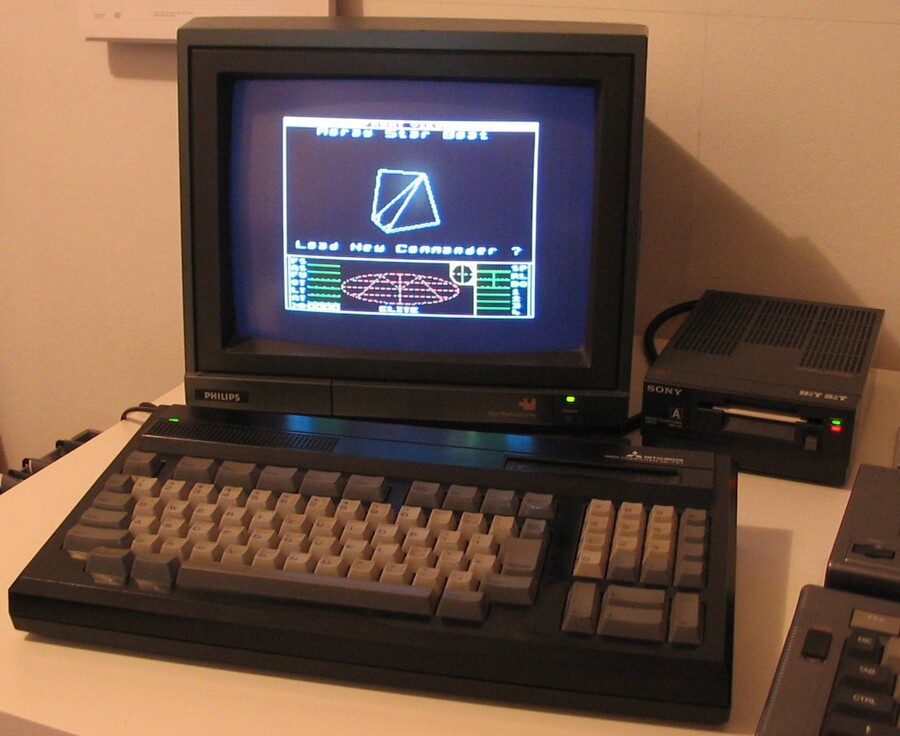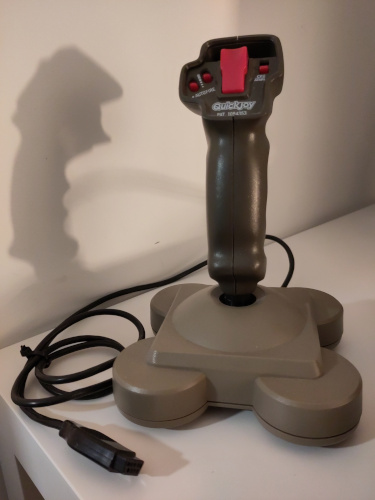My Mitsubishi ML-FX1
April 22, 2024
My first computer was an MSX, made by the Japanese giant Misubishi Electric (三菱電機株式会社, Mitsubishi Denki kabushikigaisha). It was a brilliant machine, especially since the only computer I had used before it was my father’s ZX Spectrum, a fine machine, but it looked like a very complicated little children’s toy. My MSX had a proper keyboard with a numerical island, an actual power switch at the back, an internal PSU, two Atari-standard joystick ports, a printer port, RCA audio and video out and two cartridge slots for games or hardware expansions, such as sound cards or disk drives. Rather standard for the time, you’d say, but the ZX Spectrum had exactly none of those.1
Like any MSX computer, the ML-FX1 had a Zilog Z80A equivalent NEC D780C-1 8-bits CPU clocked at 3.5Mhz. It had 64 kB RAM and 16 kB VRAM. A Yamaha S3527 chip integrated a General Instrument AY-3-8910 sound chip, controllers for joystick ports, cartridge selection, keyboard, printer and cassette interface and more. If the Z80 and the video had been integrated as well, it would have constituted a Sytem on a Chip (SoC) avant la lettre. The video controller was a Texas Instruments TMS9928ANL.

My Mitsubishi ML FX1 connected to a Philips VS0080 monitor and a Sony disk drive, playing Elite
I bought the Mitsubishi second-hand from my brother, who had bought it from a friend, who used the money to buy sneakers. My brother’s friend was actually the Mitsubishi’s first owner. He had bought the ML-FX1 on December 12, 1985, at least according to the handwritten date on the shop’s sticker that’s still on the underside of the case. The shop was from a chain called Funtronics, which was bought in 2003 by another Dutch computer manufacturer and shop chain, Paradigit. Until then, Functronics was the place to go for anything computer related, like floppies and magazines, in our sleepy border town Emmen.

On the back, from left to right, are the second cartridge slot, mostly used for hardware expansions such as the floppy drive unit seen above, a Centronics printer port, RCA audio and video output ports, an RF output, a power button and an integrated power cable.

The right-hand side of the ML-FX1 had the two standard Atari joystick ports and a cassette recorder port. Even the cassette experience of this computer was superior to Sinclair’s. The sound was muted, the tape deck’s motor could be controlled from the computer and the data transfer speed could be set to 1200 or 2400 baud.
RCA ports are by no means of RGB or SCART quality, but far better than an RF output that combined both video and audio into something that could be selected as a TV channel, much like a VHS video recorder. I didn’t own a monitor right away, but even the small CRT bedroom TV that I used at the time had RCA inputs, so the image quality was pretty close to that of an actual CRT monitor.
I also, sadly, didn’t own a disk drive right away (they were expensive), so I was forced to use cassette tapes for any game I didn’t have on cartridge. Those tapes were easily copied with double tape decks in those days. Each tape contained ROM dumps of a couple of games, prepended with a small BASIC program that would automatically run on being loaded. It would then proceed to load the next binary file on the tape, byte for byte, into one or more free memory segments as needed and when it was done, tell the CPU to start at the first memory address. The computer wouldn’t care whether the game was in ROM or RAM, as long as someone told it where the game resided.
With a black case, there hasn’t been any decolouring since 1985, like you see with so many PCs, Amigas, C64s and other beige machines. The keys, however, needed some cleaning not too long ago. Pulling them from the case was easy with a standard key puller.

Don’t let the domes fool you. Underneath is just a rubber membrane. But that didn’t matter. We hadn’t used a good keyboard ever, and that was not something we were going to be opinionated about. We used the internal BASIC editor to type in game listings from magazines and even let them inspire us to create our own games. MSX BASIC provided ways to control the audio and video chips without any machine code, like a command that would accept strings with the actual names of the notes we knew from our music lessons to play, for instance, Frère Jacques in canon:
PLAY "cdeccdec","efggefgg","l8gagfl4ecl8gagfl4ec"The PLAY command was asynchronous and would end as soon as it had pushed those strings to the audio chip, so that the music and other sounds could play in the background while the rest of the program continued.
We used matrix paper to design 8 x 8 pixel sprites which we could give a single colour and put into one of 31 layers using:
PUT SPRITE layer,(x,y),colour,spriteBASIC provided a simple hook to detect collisions and tell the program at what line in the program to continue when that happened. It was very convenient. And how did we know all this without an internet? Simple. Books. Books that told you in a few chapters how to use all the functions, but forgot to tell you how to program. It didn’t matter. Creating the games was an adventure in itself. It had to be. Our games were too slow to be playable. That wasn’t the fault of the machine. We were children. We didn’t know the first thing about programming.
But for the ROM dumps and other commercial games, we mostly didn’t need the keyboard. We used big joysticks (no controller pads) like this one:

The mighty QuikJoy JetFighter had an auto-fire switch that would, when holding the fire button, send a fast pulsed signal to the computer, instead of a continuous one, making games like Nemesis and Salamander a lot easier, if not actually playable.
I still own the ML-FX1 and I did finish Elite on it, although I had already owned several MSX2s at that point. Sometimes I feel like playing MSX1 games on an actual MSX1 instead of the Sony MSX2+ I normally use. That, after almost 40 years, I can still grab the ML-FX1 from its shelf and hook it up to a monitor and speakers for some gaming, without any maintenance, except for a single keyboard cleaning session, is a testament to its build quality.













